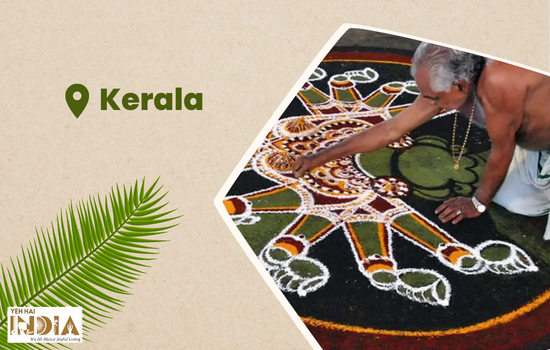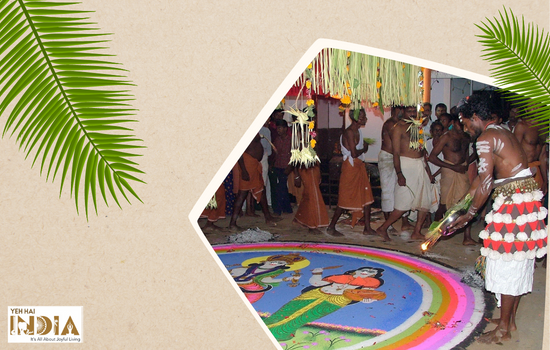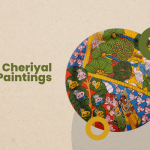Kalamezhuthu Pattu is a dramatic floor art that represents the religious practices followed by many different communities in Kerala.
Floor art is an amazingly beautiful ancient art that captures not just the heart of a particular culture but also unites the locals to showcase their unique talents they learned from their ancestors.
Every culture and region has their own unique version of floor art inspired and perfected by years of tradition. Rangolis, alponas, and kolams are testament to the above statement. Similarly, Kalamezuthu Pattu is a floor art that is unique to Kerala alone.
Known by many names such as Dhulee Chitram, Kalam Pattu and even Kalamezhuthu paintings, it ultimately means ‘to draw a picture’. It was initially derived from Hindu religious rituals before evolving into its own art form.
Initially, Kalamezuthu paintings were part of a religious ritual that worshipped several deities including Ayyappan (the son of Shiva and Vishnu), Sarpa (Naga), Bhadrakali (a form of Goddess Parvati) and Vettakkorumakan (son of Lord Shiva).
The art involves not only painting but also chanting, singing, dancing and otherwise expressing your devotion to the above Gods which is what makes this floor painting a truly unique ritual as well as art form.
The Origin:

Kalamezhuthu paintings are created by various communities within Kerala. Traditionally, it is the Puttu Kurup community that creates these paintings.
Other communities include Theeyadi Nambiar, Kaniyan, Vannan, Kuravar, Koppaalan, Malayan, Theeyatunni, Parayan, Varanattu, Theyyampadi Nambiar and more.
Each of the communities have their own variation when it comes to the creation of these paintings but generally, a number of artists create the paintings in conjunction with each other.
The rituals and the other practices, however, tend to be similar. Apart from the artist, the rest of the community also gets involved in the making of a painting.
A separate pavilion is set up for the rest of the community known as the paatu mandapam which literally translates to the ‘music pavilion’.
This is where the rest of the community participates by singing, dancing, and honouring the gods.
Recommended Story – 10 GI Protected Art Forms of India
Ritualistic Preparations :

Firstly, a paatu mandapam is set up. This can be within the temple premises itself or in a separate space nearby.
The space is decorated and made auspicious with flower garlands, oil lamps or diyas and devotional markings. Once the space has been prepared, a long silk cloth is laid across the centre.
Once, the space has been prepared, an uchapatti or a pooja is conducted for the deity in question. Once the pooja has been conducted, it is believed that the deity is present in the mandap with the devotees then onwards.
A representative of the Kurup community is then handed the silk cloth which they will place on top of the pavilion. The Marrar community plays the drums and the rest of the Kurup community starts singing the thottams or devotional songs.
Other traditional instruments such as the kuzhi thailam (cymbal) and nanthuni are also played.
The music plays continuously until the end of the ritual and is accompanied by the beautiful choruses of singing voices. However, the songs sung and played and other rituals conducted will differ according to the deity that is being worshipped.
The Actual Procedure:

Only when the proper rituals have been conducted during the opening can the floor art or the ‘kalam’ itself be made. This usually takes place during the evening once the deeparadhana (the pooja), the keli and the thayambaka have been completed.
The artist then begins to draw the image of the deity. In the entire image, only five colours are used by the artist ; black, white, yellow, red and green which are created out of natural materials only.
The art is begun with a single straight line that is drawn from East to West. All of the outlines are generally done in white. The face and the crown of the deity are drawn first before more details are added.
Natural colours are used to give the image a three dimensional effect that seems to make it lift right off the floor.
White colour is prepared using rice powder whereas black colour is prepared using burnt husk. Green is created from a multitude of botanical sources like cassia, henna and other kinds of leaves.
Yellow colour is used in the form of turmeric powder, while a mixture of turmeric powder and lime water is used to prepare red colour. The colours are meant to represent the ‘pancha bhoota’ or the five natural elements of the world.
The entire process takes from two to four hours. The entire portrait is made by hand without the use of a stencil or any other tool. On average, the whole picture is around ten feet tall but it may differ according to the deity, the opulence of the temple and the ritual and the vastu shastra.
Even while the art is being made, the musical performances continue. The instruments played then are kuzhal (a wind instrument), chenda (a percussion instrument), ilathalam (a cymbal like instrument used to create a rhythm), and madhalam (another percussion instrument).
The Concluding Ceremony:

Once the figure and the devotional singing has come to an end, the Komaram takes charge of the ceremony. This person usually hails from the priestly or Namboodhiri community and performs the closing rituals of the ceremony.
The main important ritual is the kalapradikshanam. This literally translates to a revolution around the art and includes Komaram dancing to the tunes of traditional instruments while circling the art itself in honour to pay his respects.
This is followed by the nalikerameru where coconuts are broken and offered to the deities. This is an almost antithesis to the usual Hindu ritual where coconuts are broken in the beginning of an auspicious ritual. The final closing of the ceremony is called the kalamakkal.
The Kalamezhuthu Paintings are a unique floor art that is specific to Kerala and the devotional rites of the people belonging to these communities.
It is our responsibility to be aware of these arts and to encourage everyone to develop a bonding with the culturally important art forms so that they can truly thrive in our modern world.
Kalamezhuthu Pattu is one of those rarest culturally significant art forms that not just deserve your attention but must be examined thoroughly to understand the finer traits of their place of origin
Also Read – Bhil Art: A Beloved Folk Art Form of Central India










